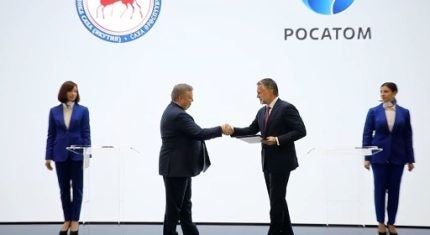
Rosatom and the Government of the Republic of Sakha (Yakutia), on the sidelines of the St Petersburg International Economic Forum signed an agreement to ensure the conditions for the efficient launch of a low-powered NPP (ASMM – Atomnoi Stantsii Maloi Moshnosti) and the development of related electric power infrastructure.
The document was signed by Rosatom First Deputy Director General for Development & International Business Kirill Komarov and Chairman of the Government of Yakutia Kirill Bychkov.
The Yakutia Government, together with federal executive bodies and relevant departments, intends to organise all the electrical infrastructure necessary for the ASMM, including distribution networks (power lines and substations) in the settlements adjacent to the Deputatskoye, Tirekhtyakh and Kyuchus fields.
“It is important that the Yakut NPP will provide stable and low-carbon generation to large industrial consumers and will become the energy centre of the region,” said Kirill Komarov. “Of course, after putting the nuclear power plant into operation, it is very important to ensure its utilisation, which will become possible thanks to the work of new industrial enterprises, the creation of social and transport infrastructure facilities and, as a result, the growth of the region’s population. Taking into account the development of current and promising fields in Verkhoyansk and Ust-Yansky, the needs of mining enterprises will exceed 90 MW of electrical power,”
Kirill Bychkov stated: “We will provide all possible support in stimulating the development of the Arctic territories of Yakutia, where there is huge potential for creating a mining cluster. If we talk about the forecast of electricity consumption by the population and equivalent categories of consumers, then in the village of Ust-Kuiga it is planned to increase the volume of energy supply to 5 MWe, and in the village of Deputatsky to 7 MWe. We are also considering the possibility of electric heating in the village of Ust-Kuiga in a volume of at least 2 MWt. Our joint calculations with the Rosatom State Corporation show that 55 MWe of power from one RITM-200N reactor plant will clearly not be enough for this industrial cluster, so we are working with federal ministries and departments on the transition to a two-unit design for the Yakut NPP.”
The project for the construction of Russian design ASMMs uses the latest RITM-200N reactor plant, which is based on many years of experience in operating small reactors on ships of the Russian nuclear icebreaker fleet (more than 400 reactor-years). The implementation of the NPP project will ensure energy independence and socio-economic development of Arctic Yakutia. ASMM refuelling takes place once every five years, which makes it possible to ensure a stable energy supply to vital industrial enterprises and social facilities.
The ASMM will become the heart of one of Russia’s largest mineral resource centres, which in the future will provide electricity to industrial enterprises. This incldes the development of the Kyuchus, Deputatskoye, Tirekhtyakh fields, the construction of transport and engineering infrastructure, social facilities in the Ust-Yansky and Verkhoyansk regions, the construction of a 110 (220) kV power transmission line connecting Ust-Kuiga, Tirekhtyakh and Deputatsky. The ASMM project will bring positive transformations to the village of Ust-Kuiga and the Ust-Yansky district, which will create a developed territory that is comfortable for both work and living.
Modern ASMM projects with RITM series reactors have a high level of security achieved through multi-level systems and shell barriers, as well as a combination of active and passive safety systems. These systems prevent the possibility of an accident, and several levels of barriers embedded in the design of stations exclude the release of radioactive substances into the environment. ASMM make it possible to ensure energy independence of the region, stable electricity and heat supply with clean energy, including for energy-intensive industries, to reduce emissions of harmful substances into the atmosphere by replacing existing sources of generation, in particular diesel ones.






